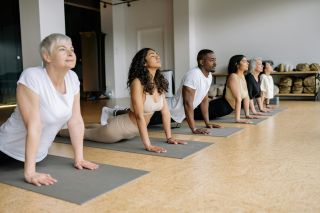Social Life
4 Ways to Optimize Your Social Health
Connection is like exercise. Here's how to strengthen your social muscles.
Updated June 20, 2024 Reviewed by Jessica Schrader
Key points
- Social health is the dimension of your overall health that comes from connection with others.
- Just as you exercise your muscles to be physically healthy, your social muscles need exercise as well.
- Strategies to help optimize your social health include stretching, resting, toning, and flexing.

Research has proven that human connection, like exercise, is vital to your well-being and longevity. For instance, people with supportive relationships are more likely to enjoy stronger immune systems, lower susceptibility to diseases, and longer lifespans.
Social health is the dimension of your overall health that comes from connection with your family, friends, co-workers, and community—and it’s as essential to thriving as physical and mental health. The importance of social health underscores that just as you take steps to strengthen your physical muscles, you should take steps to strengthen your social muscles. But where to begin?
In my new book, The Art and Science of Connection: Why Social Health is the Missing Key to Living Longer, Healthier, and Happier, I outline a three-step approach to evaluating your current social health and identifying opportunities to be more socially healthy. Depending on the quantity and quality of connection in your life at this time, there are four strategies you might need to optimize your social health.
1. Stretch
If the quantity of connection in your life is low.
You stretch your physical muscles to get more flexible and broaden your range of motion. To stretch your social muscles, take steps to make new friends, join new groups, or interact more often. This approach improves your social health by increasing the size of your social network or the amount of time you spend with others.
2. Rest
If the quantity of connection in your life is high.
It’s important to rest your physical muscles in between reps or workouts so that your body can recover. To rest your social muscles, make time to reconnect with yourself or double down on the relationships that matter most to you rather than seeking new ones. This approach supports your social health by prioritizing balance.
3. Tone
If the quality of connection in your life is low.
To tone your physical muscles, you lift heavier weights or intensify your workouts to get stronger. To tone your social muscles, focus on getting closer to your family members, friends, co-workers, or neighbors and recommitting to the groups you care about. This approach bolsters your social health by deepening the bonds you have with others.
4. Flex
If the quality of connection in your life is high.
You flex your physical muscles to show your strength and reinforce the effort you’ve put in. To flex your social muscles, enjoy the relationships you have cultivated and the groups you belong to and sustain those connections over time. This approach maintains your social health by ensuring that it stays a priority in your life.
This framework can help guide your thinking and the actions you take to optimize your social health. Just as you exercise your muscles to be physically healthy, stretch, rest, tone, or flex your social muscles to be socially healthy.
This post was adapted from The Art and Science of Connection, which contains research-backed tips for each strategy and other insights for living a socially healthy life. Reprinted with permission from HarperOne, an imprint of HarperCollins Publishers. Copyright 2024.


